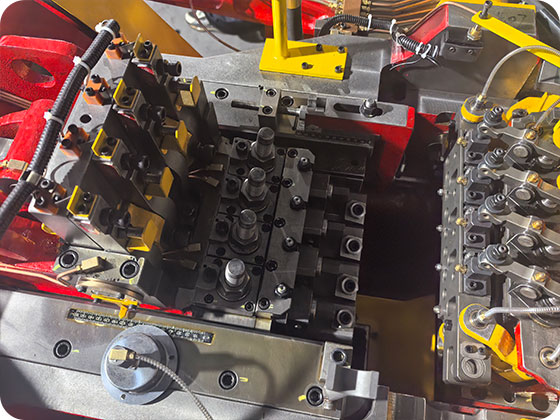If you are interested in WXING's bolt formers, you must read this article. Basically, we have 2 kinds—3-station and 4-station. Both machines excel in high-speed cold forging, yet they cater to slightly different production needs.
The 3-station machine focuses on fast, multi-part processing of ordinary hex bolts and nuts, while the 4-station machine extends functionality to a wider range of fasteners, offering sequential automated operations from cutting to thread rolling. Understanding their differences can guide manufacturers in selecting the right equipment for their workshop.
All the comparisons are based on the data sheets, which are precise.

The 3-station cold heading machines operate at speeds ranging from 16 to 240 pieces per minute, depending on model specifications. They are ideal for workshops aiming for high-speed production of standard bolts. In contrast, the 4-station machines offer a more consistent speed range of 45 to 210 pieces per minute, providing steady output while accommodating more complex operations. For high-volume standard bolt production, the 3-station machine may slightly edge out in peak speed, whereas the 4-station machine excels in maintaining continuous automated workflow with multiple forming steps.
Bolt diameter compatibility is a key consideration. The 3-station machines handle bolts from 3 mm up to 13 mm in diameter, covering most standard internal and external hex bolts. Meanwhile, 4-station machines support a similar range but extend up to 16 mm for certain models, making them suitable for heavier fasteners. The broader diameter range combined with sequential operations allows the 4-station machine to accommodate more specialized fastener production, including bolts, nuts, nails, rivets, and steel balls.

The maximum cut-off diameter and length define the size of blanks a machine can process. 3-station machines support up to 15 mm in diameter and 250 mm in length, sufficient for medium-sized bolts. The 4-station cold heading machines can reach up to 20 mm in diameter and 285 mm in length, offering extra flexibility for larger fasteners. This difference is particularly significant for manufacturers dealing with heavy-duty applications, where longer or thicker bolts are required.
Forging force determines how well a machine can handle high-strength materials. 3-station machines range from 35,000 kg to 115,000 kg of forging force, suitable for standard bolt grades. 4-station machines provide 40,000 kg up to 210,000 kg, offering greater capacity for high-strength materials or larger fasteners. This added force, combined with sequential operations, ensures consistent shaping, chamfering, and diameter reduction even for tougher metals.
The 4-station machines shine in versatility. Beyond standard bolts, they are capable of producing nuts, nails, rivets, and steel balls in a single automated workflow. The 3-station machines, while high-speed for standard bolts and nuts, do not provide the same breadth of multi-step operations. For workshops seeking flexibility and broader product lines, the 4-station machine provides a distinct advantage.
This comparison highlights key differences between 3-station and 4-station cold heading machines, focusing on production speed, bolt compatibility, cut-off dimensions, forging force, and versatility. Other factors, such as energy consumption, die change convenience, and maintenance considerations, are not emphasized here. Manufacturers with questions or purchase intentions are encouraged to contact us for tailored advice and more detailed specifications.